Chapter 23.716
LANDSCAPING
Sections:
23.716.030 Landscape plan and irrigation plans required.
23.716.040 General location for landscape improvements.
23.716.050 Landscape design and planting requirements.
23.716.060 Special landscape provisions.
23.716.070 Parking lot landscape.
23.716.080 Removal and replacement of landscaping and trees from approved plans.
23.716.090 Replanting requirements and replacement fee.
23.716.100 Landscape care and maintenance.
23.716.010 Purpose.
This purpose of this chapter is to establish minimum landscape standards to enhance the appearance of developments, reduce heat and glare, control soil erosion, conserve water, ensure the ongoing maintenance of landscape areas, and ensure that landscape installations do not create hazards for motorists or pedestrians. [Ord. 4-2017 § 3 (Exh. B); Ord. 12-2011 § 3 (Exh. A); Ord. 27-2008 § 1 (Exh. A § 4.6.010)].
23.716.020 Applicability.
A. New Projects. New nonresidential, mixed-use, multifamily residential, and single-family residential subdivisions shall provide landscaping in compliance with the requirements of this chapter.
B. Existing Development.
1. Existing nonresidential, mixed-use, multifamily and/or single-family residential development shall comply with the minimum maintenance provisions of this chapter (RCMC 23.716.060(A) and 23.716.100).
2. Proposed amendments to existing nonresidential, mixed-use, and/or multifamily projects that increase the building square footage by 10 percent or more shall comply with all of the minimum requirements of this chapter as deemed necessary and appropriate by the approval authority through the minor design review approval process.
C. Changes to Existing Site Landscaping. When significant changes are made to required elements of existing site landscaping (e.g., parking lot shade canopy trees, pervious surfaces, buffer areas, landscape screens) of a nonresidential, mixed-use, and/or multifamily residential project, provisions of this chapter apply to the affected area. Minor design review may be required according to Chapter 23.140 RCMC (Minor Design Review).
D. Minor Changes to Standards. As part of the design review (minor or major) process, the designated approval authority may authorize minor deviations from the requirements of this chapter where said changes are determined to achieve the objectives of this chapter.
E. Flexibility. As part of design review, the designated approval authority may modify the standards of this chapter to accommodate alternatives to required landscape materials or methods, where the designated approval authority first determines that the proposed alternative will be equally effective in achieving the purposes of this chapter. [Ord. 4-2017 § 3 (Exh. B); Ord. 12-2011 § 3 (Exh. A); Ord. 27-2008 § 1 (Exh. A § 4.6.020)].
23.716.030 Landscape plan and irrigation plans required.
A. Preliminary Landscape and Irrigation Plan. A preliminary landscape plan and irrigation plan shall be submitted for each application for new development or existing development as identified in RCMC 23.716.020 (Applicability). This plan would conceptually show locations for trees, shrubs, ground cover, etc. Additionally, this would also include a list of tree species and size and the location of any required purple pipe system.
B. Final Landscape and Irrigation Plan. A final landscape and irrigation plan shall be submitted in conjunction with site improvement plans and reviewed and approved by the director prior to issuance of building permits and/or any installation of landscape materials for projects as identified in RCMC 23.716.020 (Applicability). The final landscape planting and irrigation plan shall be prepared by a registered licensed landscape architect. Final plans would show exact locations and irrigation for trees, shrubs, and ground cover. [Ord. 4-2017 § 3 (Exh. B); Ord. 12-2011 § 3 (Exh. A); Ord. 27-2008 § 1 (Exh. A § 4.6.030)].
23.716.040 General location for landscape improvements.
Landscaping shall be provided in the following locations for all types of development as listed below and as illustrated in Figure 23.716-1 (Required Landscape Areas), unless the designated approval authority determines that the required landscape is not necessary to fulfill the purposes of this chapter. Nothing in this chapter is intended to discourage landscape areas outside and beyond the minimum requirements listed herein.
A. Setbacks. All setback areas required by this code shall be landscaped in compliance with this chapter except where a required setback is occupied by a sidewalk or driveway.
B. Unused Areas. All areas of a project site not intended for a specific use or purpose in conjunction with a current application, including pad sites being held for future development, shall be landscaped and irrigated.
C. Parking Areas. In parking lots, landscaping shall be used for shade and climate control, to enhance project design, and to screen the visual impact of vehicles and large expanses of pavement consistent with the provisions of this chapter.
Figure 23.716-1: Required Landscape Areas
Setbacks Unused Areas Parking Areas
[Ord. 4-2017 § 3 (Exh. B); Ord. 12-2011 § 3 (Exh. A); Ord. 27-2008 § 1 (Exh. A § 4.6.040)].
23.716.050 Landscape design and planting requirements.
A. Landscape Design. Landscaping shall be designed as an integral part of the overall site plan with the purpose of enhancing building design and public views and spaces, and providing buffers, transitions, and screening. At a minimum, the following landscape design provisions shall apply:
1. Planting design shall have focal points at project entries, plaza areas, and other areas of interest using distinct planting and/or landscape features.
2. As appropriate, building and site design shall include the use of pots, vases, wall planters, and/or raised planters, as well as flowering vines both on walls and on arbors.
3. Landscaping shall be designed with pedestrian paths throughout the landscape areas connecting designated on-site pedestrian circulation.
4. Amenities such as seating areas shall be incorporated. Entry plazas, bicycle parking, and transit shelters are allowed within landscape areas. Also see Chapter 23.722 RCMC (Standards for Pedestrian-Oriented Spaces).
5. Landscape design shall meet crime prevention through environmental design principles, including:
a. All trees shall have a minimum clearance under the canopy of six feet at maturity to allow for surveillance to occur throughout the site.
b. Within three feet of walking paths, all shrubbery shall have a height of not more than two feet to eliminate opportunities for criminals to “lie in wait.”
B. Plant Type. Landscape planting shall emphasize drought-tolerant and native species (especially along natural, open space areas), shall complement the architectural design of structures on the site, and shall be suitable for the soil and climatic conditions specific to the site.
1. Planting Layout and Plant Diversity. Plant selection shall vary in type and planting pattern. Informal planting patterns are preferred over uniform and entirely symmetrical planting patterns. Use of flowering trees and colorful plantings is encouraged in conjunction with evergreen species. Groupings of shrubs shall contain multiple plant types, interspersed with varying heights and blooming seasons for year-round interest.
2. Street and Parking Lot Trees. Street and parking lot trees shall be selected from the city’s adopted master list of street trees and parking lot trees. A minimum of 30 percent of the street trees and parking lot trees, respectively, shall be an evergreen species.
3. Trees planted within 10 feet of a street, sidewalk, paved trail, or walkway shall be a deep-rooted species or shall be separated from hardscapes by a root barrier to prevent physical damage to public improvements.
C. Planting Size, Spacing, and Planter Widths. In order to achieve an immediate effect of a landscape installation and to allow sustained growth of planting materials, minimum plant material sizes, plant spacing, and minimum planter widths (inside measurement) are as follows:
1. Trees. The minimum planting size for trees shall be 15-gallon, with 25 percent of all trees on a project site planted at a minimum 24-inch-box size. For commercial, office, community/civic, and industrial development, tree spacing within the perimeter planters along streets and abutting residential property shall be planted no farther apart on center than the mature diameter of the proposed species. Minimum planter widths for trees shall be between five and 10 feet, consistent with the city-adopted master tree list for street trees and parking lot trees.
2. Shrubs. Shrub planting shall be a minimum five-gallon size. The minimum planter width for shrubs is four feet.
3. Ground Cover. Plants used for mass planting may be grown in flats of up to 64 plants or in individual one-gallon containers. Rooted cuttings from flats shall be planted no farther apart than 12 inches on center, and containerized woody, shrub ground cover plantings shall be planted no farther apart than three feet on center in order to achieve full coverage within one year. Minimum planter width for ground cover is two feet, with the exception of sod, which requires a minimum planter width of six feet.
4. Additional Spacing Provisions. Tree spacing shall ensure unobstructed access for vehicles and pedestrians and provide clear vision at intersections. Specifically, tree planting shall comply with the following spacing criteria:
a. Trees or shrubs with a full-grown height equal to or greater than 30 inches shall not be planted in any clear vision triangle.
b. A minimum distance of 15 feet is required between the center of trees and shrubs to streetlight standards and fire hydrants. [Ord. 4-2017 § 3 (Exh. B); Ord. 12-2011 § 3 (Exh. A); Ord. 27-2008 § 1 (Exh. A § 4.6.050)].
23.716.060 Special landscape provisions.
A. Residential Landscape. For single-family and two-family residential zoning districts, at least 25 percent of the lot area shall be pervious surface. Additionally, no more than 40 percent of the front yard area shall be nonpervious surface (e.g., sidewalks, driveway or parking). Driveway pavement shall be five feet from the side property line in order to provide an area of landscaping between adjacent lots. This setback requirement excludes pedestrian walkways from the driveway to the side yard area. Deviations from these standards may be allowed through site plan and architecture review for small-lot single-family developments at the time of master home plan review where these standards cannot be attained due to design. Remaining unpaved portion shall be landscaped, irrigated, and maintained. See Figure 23.716-2 (Nonpervious Surface Limits in Single-Family and Two-Family Residential Zones). Landscaped (pervious) areas shall include a combination of well-maintained ground cover, shrubs, hedges, trees and other pervious landscape materials.
Figure 23.716-2: Nonpervious Surface Limits in Single-Family and Two-Family Residential Zones
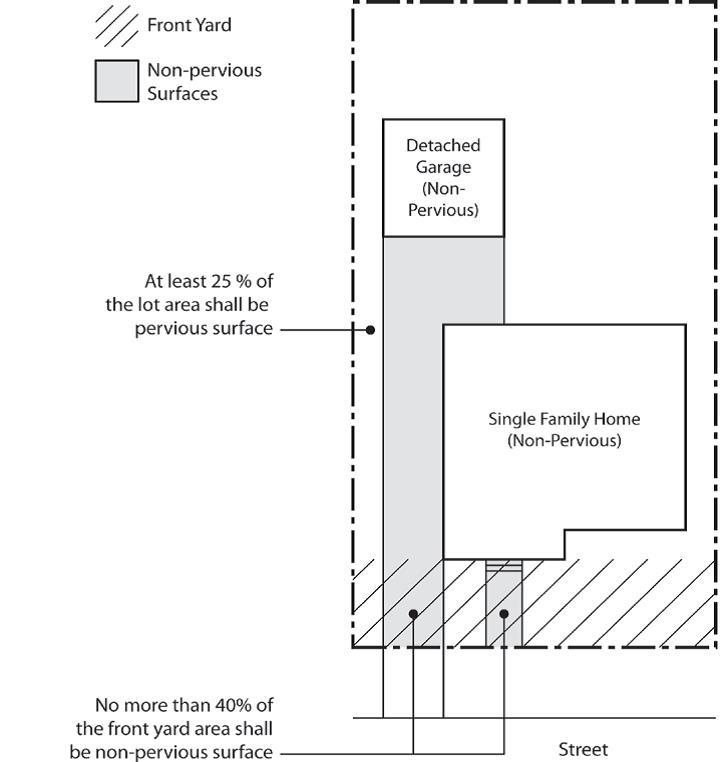
Figure 23.716-2a: Nonpervious Surface Limits in Single-Family and Two-Family Residential Zones – Irregular Shaped Lots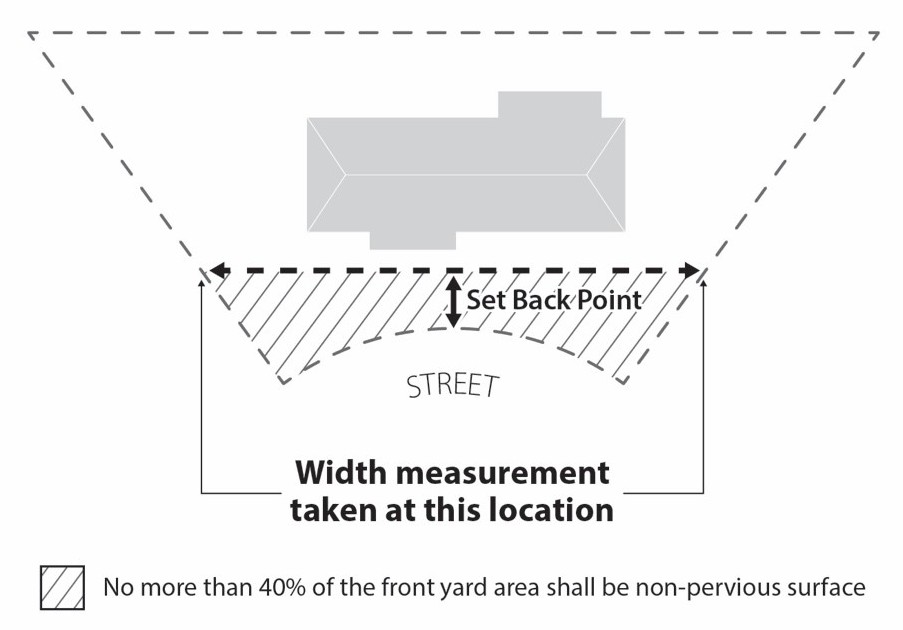
B. Project Entry Landscaping. Entries to multitenant projects shall be designed as special statements reflective of the character and scale of the project in order to establish identity for tenants, visitors, and patrons. Flowering access plantings and specimen trees shall be used to reinforce the entry statement.
C. Screening of Drive-Through Aisles. In order to screen vehicles in a drive-through lane and associated headlights from view of abutting street rights-of-way, a five-foot-wide planter between the drive-through aisle and the parking area shall be established. The planter shall include a minimum two-foot-tall (maximum three-foot-tall) landscape barrier planted with trees and other landscaping consistent with those in the parking area. At no time shall this landscape barrier be pruned in a manner that allows the vehicle headlights from the drive-through lane to be visible from abutting street rights-of-way. Plantings shall also be designed to discourage potential safety issues (e.g., persons lying in wait).
D. Service Stations. For service stations, as defined in this code, a minimum of 20 percent of the lot area shall be landscaped. A minimum of 70 percent of the landscaped area shall be covered with live landscaping, such as lawn, ground cover, trees, or shrubs, and not more than 30 percent of the landscape area shall be covered with hard surfaces, such as gravel, landscaping rock, concrete, artificial materials, or other impervious materials.
E. Telecommunication Towers. Where appropriate, facilities shall be installed so as to maintain and enhance existing landscaping on the site, including trees, foliage, and shrubs, whether or not utilized for screening. Additional landscaping shall be planted around the tower and related equipment to buffer abutting residential zoning districts or uses, and to buffer public trails.
F. On-Site Pedestrian Pathways. Pedestrian pathway landscaping shall include shade trees placed so as to cover 60 percent of the total pathway area with tree canopies within 15 years of securing building permit.
G. Public Spaces. Pedestrian space landscaping shall include a combination of shade trees and pedestrian shading devices (e.g., canopies, awnings, and umbrellas) placed so as to cover 60 percent of the total space with a shade canopy within 15 years of securing building permit.
H. Signs. Landscaping shall be provided at the base of the supporting structure equal to twice the area of one face of the sign. For example, 50 square feet of sign area requires 100 square feet of landscaped area (see Chapter 23.743 RCMC (Signs)).
I. Planting and Overhead Utility Lines. In keeping with the purposes of this chapter, the city encourages planting within overhead utility corridors. However, landscape planting near overhead utility lines and abutting utility support structures has the potential of creating a public safety hazard by causing physical damage, disrupting service, and obstructing access. Therefore, within 20 feet of any overhead utility lines, planting restrictions are as follows (see Figure 23.716-3, Planting and Overhead Utility Lines):
1. Tree species at full growth shall not encroach within a 10-foot radial line clearance of all overhead electric utility distribution or transmission lines. Unless ground clearance is greater than 30 feet, mature tree height shall not exceed 20 feet.
2. A minimum 10-foot clearance shall be maintained around all poles and ground structures to ensure necessary fire breaks and unobstructed access.
Figure 23.716-3: Planting and Overhead Utility Lines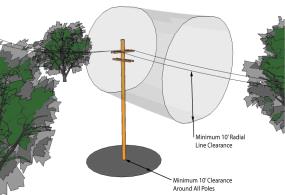
J. Water-Efficient Landscape Requirement. Development shall comply with Chapter 22.180 RCMC (Water Use and Conservation) which includes the following:
1. Submittal requirements.
2. Irrigation system design criteria.
3. Plant selection, water use calculation chart, and turf and nonturf requirements and restrictions.
4. Model home landscape criteria.
5. Soil infiltration rates.
6. Relative water requirements of commonly used plants. [Ord. 15-2023 § 3 (Exh. A); Ord. 4-2018 § 3 (Exh. A); Ord. 4-2017 § 3 (Exh. B); Ord. 13-2013 § 4 (Exh. B); Ord. 12-2011 § 3 (Exh. A); Ord. 27-2008 § 1 (Exh. A § 4.6.060)].
23.716.070 Parking lot landscape.
A. Parking Areas. All surface parking areas shall be screened from streets and adjoining properties, and the open space areas between the property line and public street right-of-way shall be landscaped. Parking areas shall be landscaped as follows:
1. Landscape Materials. Landscape materials shall include a combination of trees, shrubs, and ground cover.
2. Curbing. Areas containing plant materials should be bordered by a concrete curb at least six inches high and six inches wide. Alternative barrier design to protect landscaped areas from damage by vehicles and/or to filter/retain runoff on site may be approved by the designated approval authority. Vehicle overhang: A vehicle is permitted to overhang into a landscaped area by two feet; provided, that the required landscaped area is extended by two feet.
3. Runoff. Parking lot landscaped areas shall be designed to filter/retain runoff.
4. Location of Landscaping. Parking lot landscaping shall be located so that pedestrians are not required to cross unpaved areas to reach building entrances from parked cars. This can be achieved through proper orientation of the landscape fingers and islands and by providing pedestrian access through the landscaped areas that would otherwise block direct pedestrian routes.
B. Parking Lot Screening. Landscaping within the perimeter planter abutting any street right-of-way shall be designed and maintained for partial screening of vehicles to a minimum height of 30 inches, measured from the finished grade of the parking lot. Screening materials may include a combination of plant materials, earthen berms, solid masonry walls, raised planters, or other screening devices authorized by the designated approval authority which meet the intent of this screening requirement. Planting materials shall be designed to ensure that planting within the clear vision triangle at driveway and street intersections will not exceed 30 inches in height at full maturity. See Figure 23.716-4 (Parking Lot Screening).
Figure 23.716-4: Parking Lot Screening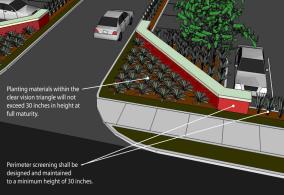
C. Planters, Landscaping. Planters containing live landscaping shall be provided adjacent to and within parking areas in accordance with the following regulations. See Figure 23.716-5 (Planter Requirements).
Figure 23.716-5: Planter Requirements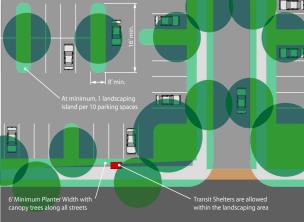
1. A planter at least five feet wide, excluding curbing, shall be provided adjacent to all street rights-of-way. The planter shall be increased to a minimum of six feet wide when canopy trees are used.
2. Transit shelters are allowed within the landscaping area.
3. Parking lots of five spaces or more shall provide a landscaped island measuring a minimum of eight feet by 16 feet at a ratio of one island for every eight spaces. As a minimum, the islands shall be placed every 10 spaces.
4. Shade Canopy Requirement.
a. Parking lot landscaping shall include shade trees placed so as to cover 50 percent of the total parking area with tree canopies within 15 years of securing building permit, illustrated in Figure 23.716-6 (Parking Lot Shade Requirements). Shade tree selection shall be approved by the director to ensure that shade canopy will be achieved. No portion of the vehicle use area shall be farther than 30 feet from the trunk of a large-type tree.
b. Tree coverage shall be determined by the approximate crown diameter of each tree at 15 years, as estimated on the approved tree list. Trees shall be a minimum 15-gallon size at planting.
Figure 23.716-6: Parking Lot Shade Requirements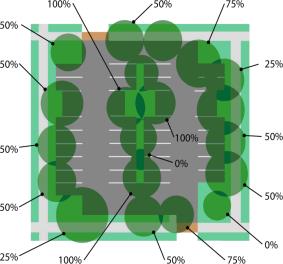
Notes:
1. This diagram is intended to reflect the manner in which shade is credited under various conditions.
2. Trees may receive 25 percent, 50 percent, 75 percent, or 100 percent as shown.
3. Shade overlap is not counted twice.
c. Solar canopies or carports can be utilized for purposes of achieving the required 50 percent shade canopy requirement. Use of solar canopies requires approval of a minor design review, unless reviewed in conjunction with a larger project requiring a major design review. The following development standards shall apply:
i. Solar canopies or carports can be installed over interior parking stalls only.
ii. Solar canopies or carports cannot be installed over parking stalls adjacent to the public right-of-way, which includes sidewalks, landscape corridors and/or streets.
iii. Existing property boundary tree canopies shall be retained.
iv. Internal landscape islands shall be planted with landscaping that can grow and thrive with limited direct sunlight.
v. Internal pedestrian sidewalks and pathways shall be kept free and clear of solar canopies.
5. All landscaping shall be within planters bounded by a curb at least six inches high. No planter shall be smaller than 25 square feet, excluding curbing. Each planter shall include an irrigation system.
6. Existing mature trees on the site shall be preserved whenever possible.
7. All landscaped areas shall be designed so that plant materials are protected from vehicle damage or encroachment.
8. All plant materials shall be maintained free from physical damage or injury arising from lack of water, chemical damage, insects, and diseases. Plant materials showing such damage shall be replaced by the same or similar species. Planting areas shall be kept free from weeds, debris, and undesirable materials which may be detrimental to safety, drainage, or appearance.
9. No more than 25 percent of the planter or landscaped area may be covered with hard surfaces such as gravel, landscaping rock, artificial turf, concrete, or other impervious materials. Bus shelters are excluded from this limitation.
10. Varied tree and plant species shall be used throughout the parking lot. No one species shall comprise more than 75 percent of the plantings within each of the following categories: shade tree, screen tree, shrub. [Ord. 5-2019 § 3 (Exh. A); Ord. 4-2017 § 3 (Exh. B); Ord. 12-2011 § 3 (Exh. A); Ord. 27-2008 § 1 (Exh. A § 4.6.070)].
23.716.080 Removal and replacement of landscaping and trees from approved plans.
A. All plant material removed from a project in which the department has approved the landscape plan or tree removal permit shall be replaced with the following replacement sizes: shrubs – five-gallon size; ground cover – flats. Replacement of trees shall be as specified in RCMC 23.716.090 (Replanting requirements and replacement fee).
B. Tree removal shall be limited to trees which are in poor health, structurally distressed, or unsafe. The removal of a tree shall be the final recourse upon determining that it is infeasible to save the tree by any other method (e.g., pruning, treatment of diseases, fertilizing). Prior to the removal of any tree, director approval is required.
The following information shall be required:
1. A written statement of the health and condition of the trees to be removed by a certified arborist.
2. Reasons for removal.
3. Landscape plan indicating size, quantity, species, and location of the trees to be removed and replaced.
C. Failure to obtain director approval prior to removing an approved tree shall require the owner of the project to replace the removed tree as stated in the replanting requirements in RCMC 23.716.090 (Replanting requirements and replacement fee). [Ord. 4-2017 § 3 (Exh. B); Ord. 12-2011 § 3 (Exh. A); Ord. 27-2008 § 1 (Exh. A § 4.6.080)].
23.716.090 Replanting requirements and replacement fee.
A. Replacement trees shall be required for trees removed with or without director approval as set forth below.
B. Trees removed or severely and improperly trimmed shall be replaced according to Table 23.716-1.
|
Size of Damaged/ |
Replacement Tree Required |
|---|---|
|
2 inches |
15-inch box |
|
4 inches |
24-inch box |
|
6 inches or greater |
36-inch box |
[Ord. 4-2017 § 3 (Exh. B); Ord. 12-2011 § 3 (Exh. A); Ord. 27-2008 § 1 (Exh. A § 4.6.090)].
23.716.100 Landscape care and maintenance.
A. Irrigation. All multifamily, nonresidential, and mixed-use development shall have a low-pressure irrigation system in 30 percent of all landscaped areas. Automatic programmable controllers with check valves shall be installed in sloping areas with elevation differences of more than five feet as defined from the toe to the top of slope. Landscape materials with the same watering needs shall be grouped together and irrigated through separate control valves. Irrigation systems shall be designed to avoid runoff, excessive low head drainage, overspray, or other similar conditions where water flows or drifts onto adjacent property, nonirrigated areas, walks, roadways, or structures. The annual maintenance program with seasonal watering schedule shall be laminated and permanently posted in or near the control box on site.
B. Maintenance of Landscaped Areas. All multifamily, single-family, nonresidential, and mixed-use development shall maintain landscape and planting areas throughout the property and in accordance with the following:
1. Planting and landscape areas shall be permanently maintained by watering, clearing debris and litter, removal of weeds and dead vegetation, pruning, insect control, and replacement of plant materials and irrigation equipment as needed to preserve the health and appearance of plant materials.
2. All landscaping shall be maintained in such a manner as to not restrict designated pedestrian access.
3. All trees, shrubs, and plants which, due to accident, damage, disease or other cause, fail to show a healthy growth shall be replaced, in kind, pursuant to the approved landscape plans within 30 days from the identified damage date.
4. Grass must be maintained below eight inches.
5. Bushes, shrubs, hedges and the like shall not project into the street, alleyway or sidewalk.
6. All impervious surface areas located in public view, such as driveways, walkways and pedestrian paths, shall be maintained free of damage, trash and debris, oils and other hazardous materials, and maintained in good condition. [Ord. 4-2017 § 3 (Exh. B); Ord. 12-2011 § 3 (Exh. A); Ord. 27-2008 § 1 (Exh. A § 4.6.100)].
23.716.110 Tree pruning.
A. Tree pruning shall be performed by a California landscape contractor. The licensed contractor shall also be certified by the International Society of Arboriculture as a certified tree trimmer or certified arborist or other qualified tree expert. See Chapter 19.12 RCMC (Preservation and Protection of Private Trees) for further tree pruning limitations and processes.
B. Tree Pruning Limitations. Tree pruning is limited to the following:
1. Remove dead wood and diseased, crowded, and weakly attached trunks and branches which create a hazard to private property and citizens.
2. Provide adequate clearance and visibility for safe use of parking stalls, travel ways, and walkways for the passage of persons and vehicles.
3. Remove visibility obstruction of traffic signs.
4. Provide adequate visibility for security patrols.
5. Repair split trees and limbs in order to save the tree and its appearance.
6. Remove or sever roots of trees which are causing damage to public or private property such as curbs, gutters, sidewalk, drainage lines, and parking lot surfaces.
7. Provide visibility for merchant signage and increase parking lot lighting only when the aesthetics of the tree and the parking lot shading requirements will not be reduced.
C. Director Approval Required to Deviate from Tree Pruning Limitations. Tree pruning beyond the limitations listed in subsection (B) of this section requires an administrative use permit (AUP) from the director and potential replacement of landscaping. [Ord. 4-2017 § 3 (Exh. B); Ord. 12-2011 § 3 (Exh. A); Ord. 27-2008 § 1 (Exh. A § 4.6.110)].


